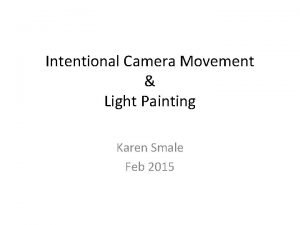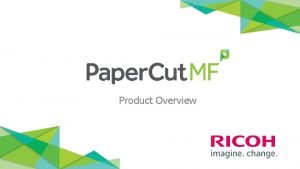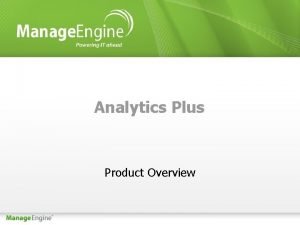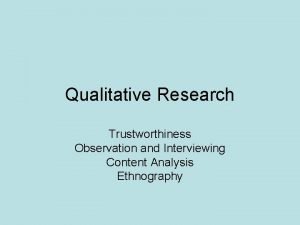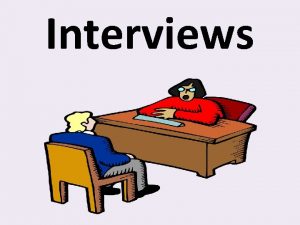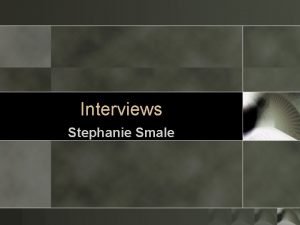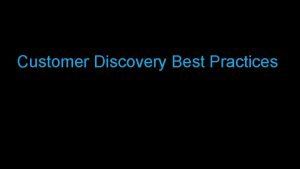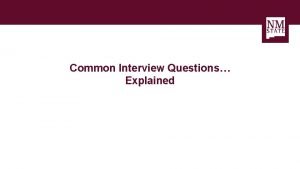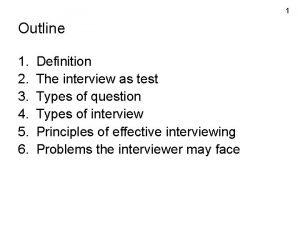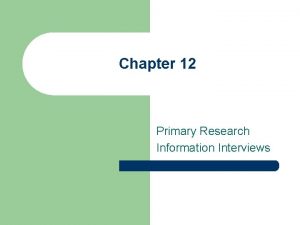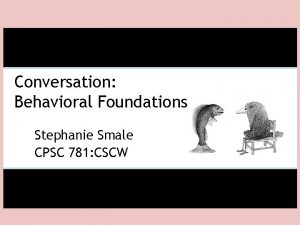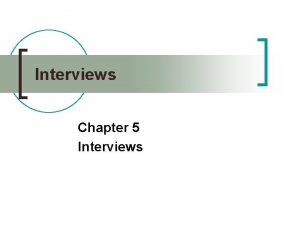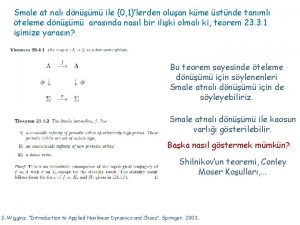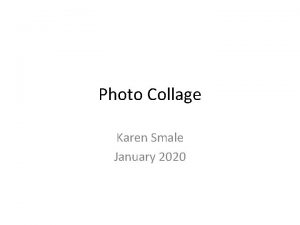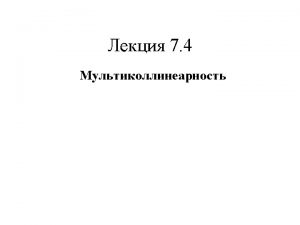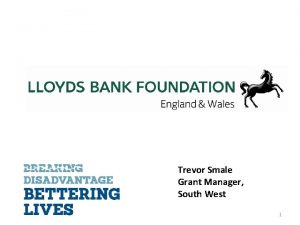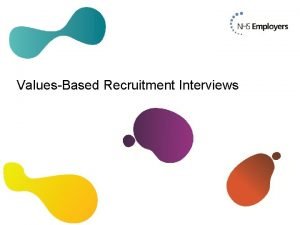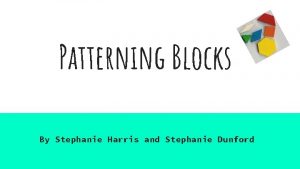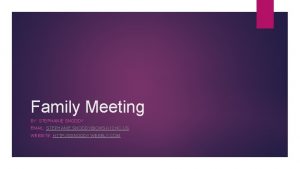Interviews Stephanie Smale Overview o Introduction o Interviews





















- Slides: 21

Interviews Stephanie Smale

Overview o Introduction o Interviews and their pros and cons o Preparing for an interview o Interview Elements: o Questions types and pitfalls o 3 types of Interviews o Structure o Rapport o Pitfalls & Response Bias o Contextual interviews o Example

Interviews o A directed conversation between people o Conducted one-on-one o Good way to measure the subjective qualities of a system o Well suited to exploratory studies o Important for influence on design and development

Pros and Cons o Interviewer may require expert domain knowledge o More costly than questionnaires o Response rate is higher o Allows rephrasing of misunderstood questions o Challenging with sensitive issues o Subject to response bias o Subjectivity

Interview Preparation o Establish interview objectives o Become familiar with end users o Choose interviewees with care o Make plans in advance o Decide on question types and interview structure o Prepare questions and interview script o Test any recording equipment, prepare any consent forms

Interview Elements: Questions o Open or Closed o Probes o General or Specific o Factual or Hypothetical o Judgmental o Comparative o Neutral o Requests (Hackos and Redish, 1998)

Question Pitfalls o Leading questions o Double-barrelled questions o Blaming questions o Jargon and specialized language o Bias and ambiguity

Leading Question (Courtesy of Edward Tse, 2003)

Interview Elements: Types o Three main types of interviews: o Structured o Unstructured o Semi-structured

Structured Interviews o Goal oriented – a preset agenda o Very well planned and controlled o Questions are predetermined o Tend to be standardized o No exploration of individual attitudes o Useful when study’s goals are clearly understood

Structured Interviews o Advantages: o Efficient o Easier to evaluate o Can compare results and analyze using stats o Interviewer training is less o Disadvantages: o Can get boring o May miss details o Difficult to build rapport

Unstructured Interviews o Conversation that focuses on one topic o Can be very in depth o Still planned, but flexible o Contains mostly open-ended questions o Acquisition of unanticipated information o Can generate rich data o Used for early requirements gathering

Unstructured Interviews o Advantages: o Provides more detailed answers o Allows for spontaneity o A skilled interviewer can build rapport more easily o Allows interviewer to adopt vocabulary of user o Disadvantages: o More time consuming o Possibility of losing control of interview o Generates a LOT of information o More difficult to analyze o Impossible to replicate o Requires a skilled interviewer

Semi-Structured Interviews o A focused interview with flexibility o Combines features of structured and unstructured interview types o Basic script used to guide interviews and maintain consistency o Starts with predetermined questions and then probes for details o Used when system requirements are understood, but opinions are not

The Interview Structure o An interview process can be divided into six phases: 1. Introduction 2. Warm Up 3. General Issues 4. Deep Focus 5. Retrospective 6. Wrap Up (Kuniavsky, 2003 b; Preece, 2002)

Rapport o Importance o Especially with unstructured formats o Encourages honesty and openness o Does not mean you are sacrificing neutrality o Respect, professionalism o Treating the user as a partner o Listening more than talking (Hackos and Redish, 1998; Kuniavsky, 2003 b)

Interview Pitfalls o Extending the interview beyond time o Missing key points o Explaining a system’s behaviour o Asking for predictions on actions o Watch for: o Perceived threat to interviewee’s self or job image o Emotional reactions o Lying or embellishments

Response Bias o Giving replies they think are desired o Socially acceptable answers o User’s vs. the system’s fault o Opinions of no importance

Contextual Interview o Part of the Contextual Inquiry technique o Helps to understand real environment o Uncovers o what people really do o how they define what is actually valuable o Based in anthropology and ethnography o Basic method involves visiting & observing o Best done at the beginning of the development cycle. (Kuniavsky, 2003 b)

Contextual Interview (http: //www-2. cs. cmu. edu/~bam/uicourse/EHCIcontexualinquiry. mpg)

Exercise o The Bad Interview o From Newman and Lamming (1995) o Find the poor techniques used o Change the element from bad to good o Reconstruct the example to have an effective interview strategy
 Karen smale
Karen smale Karen smale
Karen smale Robin smale
Robin smale What is bioinformatics an introduction and overview
What is bioinformatics an introduction and overview Papercut job tickerting print software
Papercut job tickerting print software Introduction product overview
Introduction product overview Introduction product overview
Introduction product overview Introduction product overview
Introduction product overview Qualitative vs quantitative data analysis
Qualitative vs quantitative data analysis Pros and cons of telephone interviews
Pros and cons of telephone interviews Unusual job interviews
Unusual job interviews Advantages and disadvantages of ethnography
Advantages and disadvantages of ethnography Primary research interviews
Primary research interviews Analyse af kvalitative interviews
Analyse af kvalitative interviews Types of interviews structured semi structured unstructured
Types of interviews structured semi structured unstructured Disadvantages of unstructured interviews
Disadvantages of unstructured interviews Customer interviews lean startup
Customer interviews lean startup Strength for interview for freshers
Strength for interview for freshers Disadvantages of unstructured interviews
Disadvantages of unstructured interviews General standoutishness
General standoutishness Primary research interviews
Primary research interviews Disclaimer for interviews
Disclaimer for interviews
